ACT Location Walk, Chilham, 30th August 2009
Contains spoilers about how they did certain tricks in the film
This year's gathering for the annual A Canterbury Tale location walk was in Chilham. The forecast was for "Sunny intervals. Max: 21 °C, perfect weather for a stroll through the English countryside. Driving down to Kent there were a few light showers but these proved to be a false alarm, the weather held fine all afternoon.
A light lunch and a pint in Chilham square where I met Michael Eyers and then we went down the hill to Chilham railway station where everyone was due to meet up. Quite a crowd were already there, at least 50 of them. A few greetings to familiar faces and then Paul Tritton and I introduced ourselves. Paul asked how many hadn't been on one of these walks before and about 3/4 of them raised their hands. But when he asked if there was anybody who hadn't seen the film nobody raised their hands, which was good - although we have made allowances for that in the past when people have dragged friends or partners along and they have no idea why they're there. A brief introduction to tell the first-timers what we planned to do and then off towards the mill. Mark O. & Santonix from the BritMovie Forum introduced themselves to me, nice to meet you chaps.
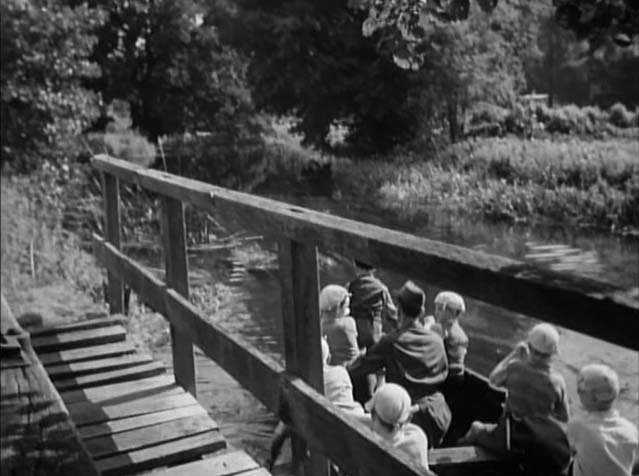
The boys set off to do battle |
The mill at Chilham was the scene of the boys' river battle and later, where the boys collected the salvage which proved Colpeper's guilt. We did the first of our playlets there, where we pull a few people out of the crowd and "volunteer" them into reading a few lines from a scene in the film that happened at that location. But this time, we could get some of the real actors from the film to read out some of the lines because we'd been joined by Len Smith who played General Leslie and David Todd who played Commander Todd (the boy crying in the back of the boat). Len quite often makes an appearance but David can't always make it for our gatherings.
John Clark, the boy sitting on the wall in the wheelwright's had set up a table where he showed his collection of postcards and photos from Chilham and some of the other villages in the area that were used in the film. He also had a DVD player running to show scenes from the film.
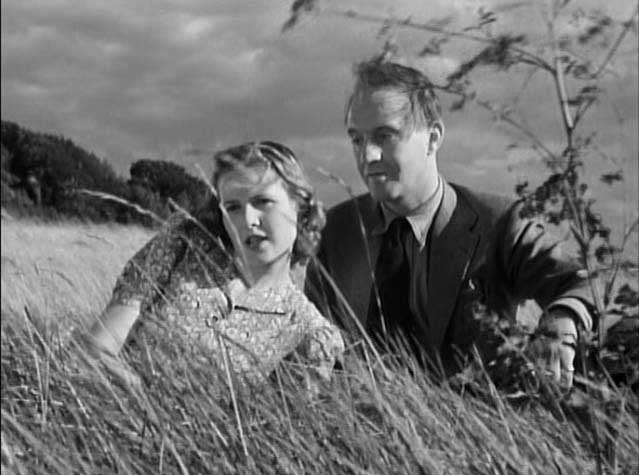
The scene in the long grass |
We went alongside the river a short way then through the woods to the fields above the river where we paused for a bit of a rest and a picnic. We had now been joined by Bryan Hawkins of the Powell Research Group at Canterbury Christ Church University. He and a colleague are doing some work on the use of landscape in P&P films and particularly in A Canterbury Tale where the landscape is like another character. They were filming and recording some of what we were doing.
We had a quick check on how energetic everyone felt and enough people felt fit enough to head for the hills! Well, not exactly hills, just the farm-land overlooking the river valley, to the field known as The Roundel. This is where Alison and Colpeper had their scene in the long grass until they were disturbed by Bob & Peter coming up the hill talking about tea and marijuana.
Paul Tritton and Helen Lawson were just finishing another playlet, reading some of that scene in the long grass, when were given a salute by The Red Arrows as they flew past on their way to a display somewhere. We couldn't manage a falcon turning into a Spitfire, but that was quite impressive.
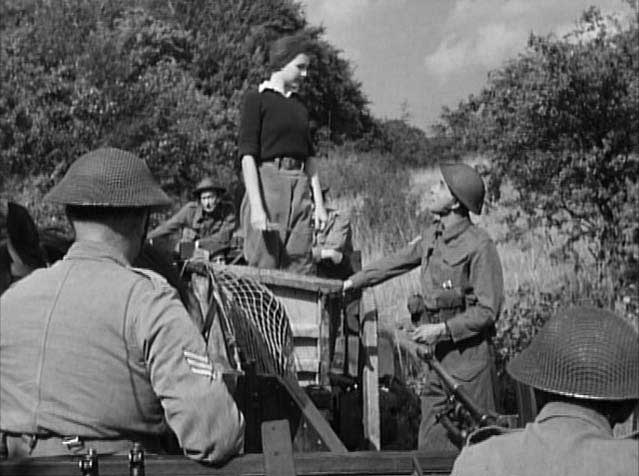
Alison is ambushed by the soldiers |
From the corner of the field containing The Roundel we could see Old Wye Lane where Alison was intercepted by the bren carriers led by Peter Gibbs. One of them comes down from the top of the Rye Field with the camera looking down the field towards Old Wye Lane. The other two carriers, including Peter's carrier, came across the fields below us. We could stand on the corner of Old Wye Lane where the camera must have been but nobody fancied the trudge up to the top of the rye Field.
This and many other places gave us an opportunity to explain how tricky Powell had been with the locations in this film. As he grew up in the area he knew every lane and every field, every village and every stream. He could choose exactly the location he wanted for every shot even if two consecutive shots in the film were made to appear to be in the same place they could really be miles apart or two locations which were made to appear to be some distance apart in the film could really be very close to each other.
When Bob looks out of one window of his bedroom on the Saturday morning he is looking out into the village of Wingham. When he looks out of another window of the same room, he is looking out at Fordwich, over 6 miles away. That must be a big bedroom!
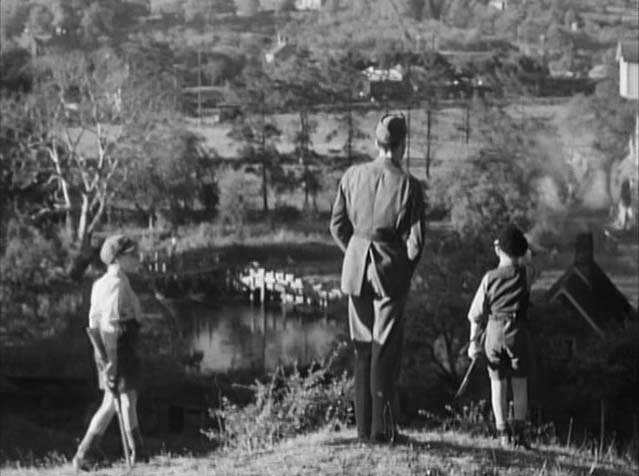
The conference on "pow-wow hill" |
Back down towards the river a short way and we come to Juliberrie's Grave, a neolithic, new stone age burial mound. In archaeological terms a Long-barrow. But it was to this hill that the boys took Bob for their "pow-wow" where he asked them where Colpeper would be likely to get his glue from. The boys agreed to act as detectives and search through the waste paper that they collected.
From Juliberrie's Grave, Bob and the boys could look down over the river and see the mill quite clearly. The trees have grown quite a bit since 1943/4 although they have recently been cut back a bit and of you get the angle right then you can see the same view down to the mill.
While he was on the hill Bob heard the church bells ringing and ran down to join the Hortons at church. He would had to have been a good runner because that church is in Fordwich, 10 miles away and the other side of Canterbury.
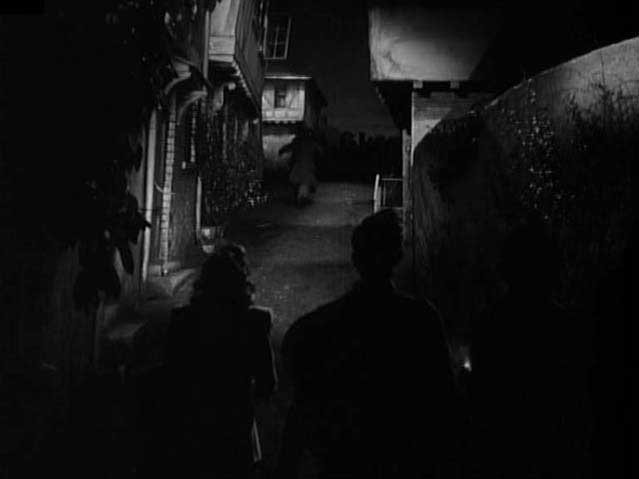
Chasing the glue man |
We made our way back into Chilham. The number of people in the group was thinning by now. Some people had trains to catch or were just tiring. It had been a warm afternoon and it was quite a climb to get up to The Roundel and back down again. We stopped off at the Woolpack for a bit of liquid refreshment and a sit. Chilham sits on top of a hill with the village square in the middle and various roads leading off in different directions. In the opposite direction to the road leading to the railway station and the mill is Taylors Hill. It was this road that gave the inspiration for the road where our heroes chase the glue man after he's attacked Alison. Looking back up to Chilham square from part way down the hill we see houses with similar jettied upper stories overhanging the ground floor and similar doorways with porches above them. This was re-created in the studio and they actually gave the models a bit of false perspective and used a small boy as the fugitive so that it looked like a man running further away.
John Sweet told us that his powerful torch was actually acetylene powered and the gas was fed by a tube that they ran down his sleeve. Watching the film again just before this trip I noticed that Bob stumbles and drops his torch as he starts to run up the hill after the glue-man. Of course he couldn't very well run up the hill trailing a tube carrying the acetylene gas to power his torch!
In another piece of movie location magic, when Bob and Peter have give the boys their reward in the mill they come out and they are suddenly on School Hill, one of the other roads leading down from Chilham Square and a couple of miles from the mill. That's where Bob throws an apple to Peter so as we were in the area we just had to re-create that scene - although with a tennis ball. It took us a few attempts to get it right. I wonder how many times they had to shoot that scene in August 1943.
And so back the main square where Bryan read out Colpeper's address from his lecture:
Well, there are more ways than one of getting close to your ancestors. Follow the old road, and as you walk, think of them and of the old England. They climbed Chillingbourne Hill, just as you. They sweated and paused for breath just as you did today. And when you see the bluebells in the spring and the wild thyme, and the broom and the heather, you're only seeing what their eyes saw. You ford the same rivers. The same birds are singing. When you lie flat on your back and rest, and watch the clouds sailing, as I often do, you're so close to those other people, that you can hear the thrumming of the hoofs of their horses, and the sound of the wheels on the road, and their laughter and talk, and the music of the instruments they carried. And when I turn the bend in the road, where they too saw the towers of Canterbury, I feel I've only to turn my head, to see them on the road behind me
A final round of applause for that, a few fond good-byes and "See you next year" and so everyone gradually headed off home. A few of us lingered for a last chat and a pint (for some, not for me this time, I was driving) and as the sun got lower on the horizon we all went our separate ways, tired, but happy.
Back to
the index






